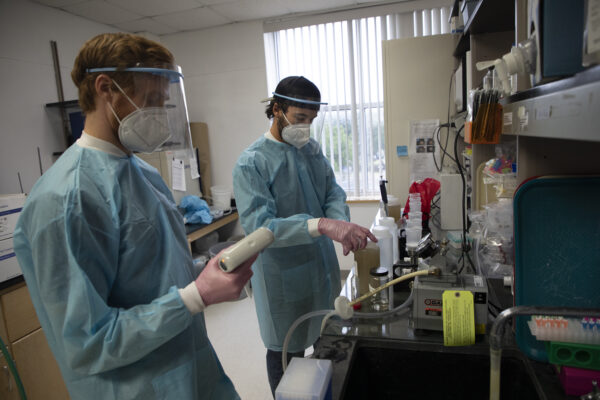UNC research technician Tom Clerkin and graduate student Mark Ciesielski turn off a gravel road and into the Beaufort Wastewater Treatment Plant. They jump out of their truck, greeted by the scorching sun and an aroma that is so unique to these types of facilities. Grabbing armloads of equipment, they climb atop the wastewater intake platform, where incoming sewage is cleared of large debris. They don full protective gear including face masks, gloves, and face shields, and collect their weekly samples. The work is far from glamorous, but serves an important purpose.
The team, led by UNC Institute of Marine Sciences microbiologist Rachel Noble, is quantifying COVID-19 concentrations in communities throughout North Carolina. While testing an individual is useful for the person who receives it, the people they come into contact with, and official coronavirus case counts, it doesn’t provide information about the number of asymptomatic people not tested — which experts believe is significant.
Noble expects their data will help account for asymptomatic carriers, identify hot spots, and inform public health measures like school policies and face mask mandates. As of August, preliminary results have shown an increase of the virus in wastewater about five to seven days before spikes in clinical cases — leading researchers to think results could serve as a sentinel for community spread.
The key, Noble says, is to focus on the concentration of the virus throughout the population.
“We’re not just looking for the positive or negative result of the virus in the wastewater samples,” she says. “What we’re looking for are the trends of whether the numbers are increasing or decreasing, and we’re particularly looking for the time whenever the signal disappears.”

Graduate student Mark Ciesielski and lab technician Tom Clerkin prepare wastewater samples for analysis in the Rachel Noble lab at the UNC Institute of Marine Sciences (photo by Megan May).
Seeing SARS-CoV-2 rapidly spread across the globe, Noble’s team proposed the study in February — weeks before the virus was considered a pandemic by the World Health Organization. Wastewater-based epidemiology was previously used to study outbreaks of polio and opioid use. Knowing coronaviruses are shed through fecal material, Noble realized this would be an efficient way to track this virus as well.
Originally focused on rural communities, collaborators from across the state joined in and broadened the project’s scope. Now, fully funded by the North Carolina Policy Collaboratory, at $1.8 million, other collaborators include the UNC Gillings School of Global Public Health, North Carolina State University, University of North Carolina Wilmington, University of North Carolina at Charlotte, NC Department of Health and Human Services, and NC Department of Environmental Quality.
Although not testing every municipality in the state, the large collaboration gives the researchers an opportunity to understand how the virus spreads through different types of communities — urban, suburban, and rural.
Still in the early phase of the project, the team has now vetted standardizing sensitive and quantitative sampling and testing methods. Eventually, Noble hopes epidemiologists will be able to translate their results into the number of individual people infected. Not only will this information inform policy this fall, but it will also lay the groundwork to help battle future outbreaks.
“There will be other coronaviruses that we face in our lifetime,” Noble says. “So, it is very interesting to think about setting up a system in North Carolina that can be more effective to identify those hot spots so we don’t get ourselves in the predicament that we are in now.”

